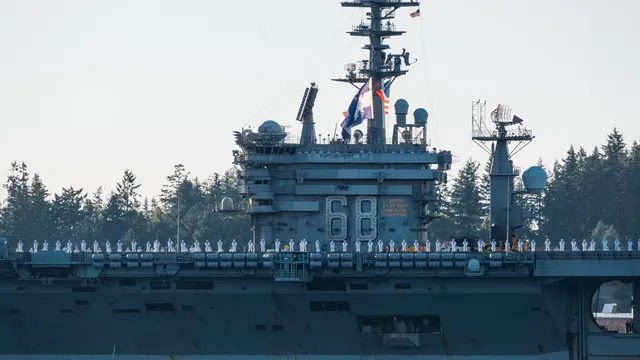
USS Nimitz prepares for decommissioning after final deployment
2025-03-28 18:05- USS Nimitz recently departed Naval Base Kitsap for its final Indo-Pacific deployment.
- The carrier, commissioned in 1975, will undergo decommissioning at Newport News Shipyard, Virginia.
- After five decades of service, Nimitz is set to be remembered as a legendary aircraft carrier.
Express your sentiment!
Insights
The USS Nimitz, the second nuclear-powered aircraft carrier ever constructed for the U.S. Navy, is nearing the end of its illustrious service life after five decades. It recently departed Naval Base Kitsap for what is expected to be its final deployment in the Indo-Pacific region, amid heightened military tensions in the area. Secretary of Defense Pete Hegseth has sent additional carrier strike groups to the Middle East, necessitating the deployment of USS Nimitz to maintain U.S. naval presence in the Pacific. Commissioned in 1975 and named in honor of World War II Admiral Chester W. Nimitz, the USS Nimitz has a storied history that includes participation in key military operations such as Operation Iraqi Freedom and various peacekeeping efforts throughout its service. This carrier, alongside its combat-ready Carrier Air Wing 17, is equipped with a variety of advanced aircraft, providing significant capabilities for aerial defense and attack missions. The decommissioning process plans to take place at Newport News Shipyard, Virginia, where numerous nuclear-powered ships undergo construction and overhaul. Given the complexities involved in dismantling nuclear vessels, the complete scrapping of the USS Nimitz could take several years, similar to the ongoing decommissioning of USS Enterprise, which began in 2017 but has yet to be fully scrapped. The USS Nimitz has played a significant role in shaping naval aviation and demonstrating the power of nuclear carrier strike groups in various global contexts. As it sails toward retirement, its legacy as a legendary carrier that contributed to U.S. maritime security will be remembered by both the Navy and the nation as a whole.
Contexts
The USS Nimitz (CVN-68) is a nuclear-powered aircraft carrier that has played a pivotal role in the United States Navy since its commissioning in 1975. Named after Fleet Admiral Chester W. Nimitz, a key figure in the Pacific Theater during World War II, the Nimitz represents a significant advancement in naval aviation technology and strategy. As the lead vessel of her class, the Nimitz-class includes several other similarly equipped carriers, showcasing advancements in naval engineering, including a length of over 1,000 feet and a displacement of approximately 100,000 tons. Its ability to carry over 60 aircraft, combined with state-of-the-art technological features, has ensured its position as one of the most formidable assets in maritime operations. The design and construction of the USS Nimitz took place at the Newport News Shipbuilding and Dry Dock Company in Virginia, with the keel laid in 1968, and launch completed in 1972. Upon its commissioning in May 1975, the ship immediately entered service, embarking on its first deployment in 1976, showcasing the United States' military capabilities during the Cold War. Throughout the decades, the Nimitz has participated in numerous significant operations, from exercises in the Persian Gulf during the Iran-Iraq War to humanitarian missions after natural disasters, such as the 2010 earthquake in Haiti. The carrier’s versatile operational capacity has made it a key asset in both peacetime and wartime scenarios. One of the notable features of the USS Nimitz is its nuclear propulsion system, which allows for extended deployments without the need for refueling, giving it a strategic advantage in various naval operations. This capability supports the carrier's role as a mobile airbase, enabling it to project air power across vast distances. Additionally, the Nimitz is equipped with advanced systems for combat and navigation, including the Aegis Combat System, which enhances its ability to operate in high-threat environments. The presence of the Nimitz Carrier Strike Group in various military theaters underscores its role in deterrence and rapid response for the United States. As of 2025, the USS Nimitz remains an integral part of the United States Navy and continues to evolve with modernization efforts that will ensure its operational effectiveness for years to come. This includes upgrades to combat systems and enhancements in aircraft capabilities, which maintain its relevance in contemporary warfare. The Nimitz has not only served as a symbol of maritime strength for the United States but has also been involved in fostering international relations and aiding allied nations through joint operations and engagements. Its storied history and continued service exemplify a legacy of excellence and resilience within the U.S. Navy.